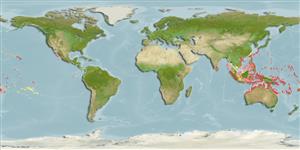>
Eupercaria/misc (Various families in series Eupercaria) >
Scaridae (Parrotfishes) > Scarinae
Etymology: Scarus: Greek, skaros = a fish described by anciente writers as a parrot fish; 1601 (Ref. 45335).
More on author: Kner.
Environment: milieu / climate zone / depth range / distribution range
Ecologia
marinhas associadas(os) a recifes; intervalo de profundidade 0 - 30 m (Ref. 128797), usually 2 - 15 m (Ref. 37816). Tropical; 30°N - 24°S
Pacific Ocean: Christmas Island in the eastern Indian Ocean (Ref. 30874), then from the Philippines to Samoa, north to the Ryukyu Islands, south to the southern Great Barrier Reef.
Tamanho / Peso / Idade
Maturity: Lm ? range ? - ? cm
Max length : 30.0 cm TL macho/indeterminado; (Ref. 2334)
Espinhos dorsais (total): 9; Raios dorsais moles (total): 10; Espinhos anais 3; Raios anais moles: 9. Males distinct and head looks bright yellow underwater; females drab with white teeth and some pale spots (Ref. 48636). Scales large. 4 median predorsal scales; a transverse pair of smaller scales which overlap medially in mid-dorsal line located directly anterior to 1st median scale; 3 scale rows on cheek, lower row with 1-2 (usually 2) scales. Caudal fin slightly rounded to truncate in initial phase; moderately to deeply emarginate in terminal phase. Adults in initial phase without canines on upper plate, 1 on lower; terminal-phase fish with 1-2 canines on upper and lower plates. Lips largely or entirely cover dental plates.
Inhabits coral-rich areas of outer lagoon and seaward reefs (Ref. 9710). Usually solitary (Ref. 9710). Females usually in small groups with a male nearby; they may mix with females of similar species (Ref. 48636). An uncommon fish patchily distributed through much of its range.
Life cycle and mating behavior
Maturidade | Reprodução | Desova | Ovos | Fecundidade | Larvas
Oviparous, distinct pairing during breeding (Ref. 205).
Randall, J.E., G.R. Allen and R.C. Steene, 1990. Fishes of the Great Barrier Reef and Coral Sea. University of Hawaii Press, Honolulu, Hawaii. 506 p. (Ref. 2334)
Categoria na Lista Vermelha da IUCN (Ref. 130435)
Ameaça para o homem
Harmless
Utilização humana
Mais informação
ReferênciasAquaculturaPerfil para aquaculturaEstirpesGenéticaElectrophoresesHereditariedadeDoençasProcessamentoNutrientsMass conversion
ColaboradoresFotografiasStamps, Coins Misc.SonsCiguateraVelocidadeTipo de nataçãoÁrea branquialOutras referênciasCérebrosVisão
Ferramentas
Relatórios especiais
Descarregue XML
Fontes da internet
Estimates based on models
Preferred temperature (Ref.
123201): 25 - 29.3, mean 28.5 °C (based on 2066 cells).
Phylogenetic diversity index (Ref.
82804): PD
50 = 0.5000 [Uniqueness, from 0.5 = low to 2.0 = high].
Bayesian length-weight: a=0.01023 (0.00436 - 0.02401), b=3.09 (2.90 - 3.28), in cm total length, based on LWR estimates for this Genus-body shape (Ref.
93245).
Nível Trófico (Ref.
69278): 2.0 ±0.00 se; based on food items.
Resiliência (Ref.
120179): Elevada, tempo mínimo de duplicação da população menor que 15 meses (Preliminary K or Fecundity.).
Fishing Vulnerability (Ref.
59153): Low vulnerability (20 of 100).
Nutrients (Ref.
124155): Calcium = 56.3 [31.4, 96.2] mg/100g; Iron = 0.782 [0.504, 1.329] mg/100g; Protein = 18.1 [16.0, 19.9] %; Omega3 = 0.058 [0.034, 0.099] g/100g; Selenium = 20.3 [10.3, 37.1] μg/100g; VitaminA = 50.8 [12.7, 199.7] μg/100g; Zinc = 2.5 [1.8, 3.4] mg/100g (wet weight);
